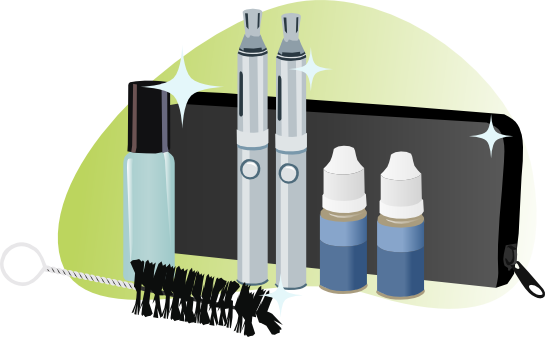Is Vaping Bad for You?
Vaping Health Risks Explained
(+Preventive Tips)
[Sassy_Social_Share]
Today you’re going to learn if vaping is bad for your health.
We analyzed over 40 scientific papers to see what the current scientific consensus is about the health effects of vaping.
On top of this, over the years, we have tested over 300 vaping devices and ran into many potential health risks that are related to improper vaporizer-use. We documented all of these.
The best part?
You’re going to learn how to minimize the biggest vaping health risks.
Keep reading.
Spoiler:
Vaping isn’t healthy, and you can never eliminate 100% of the risk. If you want to be 100% safe, don’t’ vape.
Does Science
Think Vaping is
Bad for Your Health?
No research has ever concluded
that vaping is healthy,
but when comparing vaping to smoking,
there’s no easy answer;
the results are mixed.

For example
Some researchers found a significant amount of toxins in vapor, close to what’s found in cigarette smoke.
Other researchers found vaping to be 95% less harmful than smoking.
How can there be such large differences between study results?
The only way we can come close to the truth is by analyzing these papers and look at the methods the researchers used to come to their conclusions.
We don’t take any single study as truth; Researchers can make mistakes. It’s crucial that we use our common sense and years of vaping experience as well.
Most scientific studies that looked at the health effects of vaping looked at e-cigarettes.
There are a few studies that looked at vaping marijuana as well, and the consensus of these studies is that vaping marijuana is 100% a healthier choice than smoking it (not 100% healthy though, you still risk inhaling toxins).
So if you smoke marijuana, don’t wait, get a quality dry herb vaporizer.
All the studies which you’ll read about next refer to ‘e-cigarette’ type of vapes.
E-cigarettes include:
- Box mods + vape tanks;
- Vape pens;
- Pod-systems;
- Cig-a-likes;
- Atomizers (including RDAs, RTAs, and RDTAs), or;
- Any other device that you can use with e-liquids.

CONTENTS

CHAPTER 1
Studies That Found Major
Health Risks Associated
with Vaping

This is the camp that found notable negative health effects related to vaping.
This is not the camp that thinks:
- Vaping is not a viable way to quit smoking, or
- Vaping is as harmful as smoking in every possible way.
If you want to quit smoking, of course, it would be healthiest to just quit cold turkey.
But quitting smoking cold turkey has proven to be difficult for some.
If vaping is less harmful than smoking, it still could be a viable way to quit smoking for those who have a hard time quitting cold turkey. In that sense, a vaporizer could be seen as a harm reduction tool.
That said, let’s dive right into the studies.
Toxic Levels of Metal
Concentrations in Vapor
(2018 Study) 
In 2018 researchers looked at the presence of heavy metal compounds in e-cigarette vapor.
They found that the coils in the e-cigarettes that they tested, leak toxic amounts of heavy metals when they get heated.
The research concludes as follows:

Our results add to the existing evidence that e-cigarettes are a relevant source of exposure to a wide variety of toxic metals including Cr, Ni, and Pb as well as to essential metals that are potentially toxic through inhalation such as Mn and Zn.

What we can conclude from this study
Based on:
- What e-liquid you use;
- What type of material your coil is, and;
- How often you change your coil…
Vaping could expose you to heavy metal concentrations, which are as toxic as you would get from smoking regular cigarettes.
We also see large variability in heavy metal concentrations between different e-cigarettes.
This means that certain (as of now) unknown variables have a large influence on heavy metal concentrations in vapor.
The next step is to study which variables influence heavy metal concentrations in vapor the strongest, and how these variables can be controlled to reduce heavy metal concentrations in vapor significantly.
My prediction is that:
- Vaping the highest quality vape juices;
- Vaping with the highest quality coils, and
- Vaping with the right techniques (think using the right temperature and power settings for example)…
Will release much lower concentrations of heavy metals compared to smoking cigarettes.
Only time will tell if my prediction is right.

Vaping Associated with
Increased Risk of Heart Attack
(2018 Study) 
In 2018 researchers did a survey-based study to look at whether e-cigarette use was associated with an increased risk of heart attack.
Looking at the title of this paragraph, the result of their study shouldn’t surprise you:
Daily e-cigarette use was associated with an increased risk of heart attack.
Diving deeper, they found that:
Compared to someone who never used an e-cigarette in his/her life, a daily e-cigarette user had a 1.7 increase in odds of suffering a heart attack.
When they compared smokers with non-smokers (based on earlier research), they saw the following:
Compared to someone who never used a normal cigarette in his life, a daily cigarette smoker has a 2.7 increase in odds of suffering a heart attack.

As you can see, smoking is associated with a higher heart-attack risk than vaping.
But the 1.7 increased heart-attack risk associated with daily e-cigarette use is alarming nonetheless.
Interestingly enough, former and someday e-cigarette use was not associated with having an increased risk of a heart attack.
Former and some-day (regular) cigarette smokers, on the other hand, do have an increased risk of a heart attack.
The highest risk of heart attack was associated with persons who used both e-cigarettes and regular cigarettes daily.
This last finding suggests that e-cigarette use is an independent risk factor for heart attack, on top of regular cigarette use.
What we can conclude from this study
Daily e-cigarette-use is associated with an increased risk of a heart attack.
Survey-based studies aren’t the most trustworthy studies to come to hard health-based conclusions.
But it’s probably safe to say that:
- The more you vape (in e-liquid quantities), and;
- The higher your frequency of vaping (daily vs. every other day)…
The more your vaping is contributing to an increased risk of a heart attack.
Based on this study, we can say that:
- Vaping is less harmful to your heart than smoking, but;
- Not vaping is healthier for your heart than vaping.
If you want to reduce heart-attack risk to the best of your ability, don’t vape or smoke.
But if you’re going to vape:
- Vape only one (1) time per two (2) days at most, and;
- Vape low amounts of e-liquids.
Based on this study, the researchers can’t prove that e-cigarette use is a cause for increased risk of heart attack, because the nature of survey-based studies is such that it can only show correlations/associations. But we can’t rule out that vaping is a cause for increased risk of heart attack either. Further research should make clear whether this is the case.
But if you want to be on the safe side, don’t vape.
Note that it’s also unclear what types of vaporizers and what types of vaping conditions were more strongly associated with an increased risk of heart attack.
Below you can find other research related to e-cigarettes and cardiovascular function:

E-Cigarette-Use
Associated with Increased
Inflammation Markers
(2016 Study) 
In 2016 researchers looked at the effects of e-cigarette vapor on neutrophils.
Neutrophils are a type of white blood cells which have an essential role in the human immune system.
When neutrophils get activated, it indicates that your body is suffering from inflammation.
The researchers found that e-cigarette vapor causes acute neutrophil activation that lasts up to 6 hours after exposure.

This indicates that e-cigarette vapor has a pro-inflammatory effect on the body.
The researchers think this inflammatory effect is caused by different toxins that they found present in e-cigarette vapor.
Two of the most important toxins that they found are:
- Acrolein, and;
- Styrene.
Acrolein has been shown to be a pro-inflammatory agent in various studies. But it’s also thought to be a major etiological (disease-causing) agent contributing to lung cancer.
Acrolein is also found in cigarette smoke. The researchers think that the acrolein in e-cigarette vapor is produced by heating glycerol, a compound found in most e-liquids.
Styrene has been linked to airway inflammation. The researchers think styrene might have a pro-inflammatory effect when inhaled through e-cigarette vapor.
What we can conclude from this study:
Vaping has at least some inflammatory effect on your body, and especially on your airways and lungs.
The question is to what extent this inflammatory effect depends on:
- The ingredients in e-liquids;
- The vaporizer used, and;
- The manner in which the vaporizer is used (think temperature, puff duration, etc.)
A next step would be to compare the inflammatory effects of vaping vs. smoking and see if the inflammatory effects of vaping are reducible by adjusting different variables like e-liquids, vaping conditions, and vaporizer type.

E-Cigarette Vapor Contains
Compounds with Potential
Carcinogenic Properties
(Various Studies)
Study 1, Electronic cigarette exposure triggers neutrophil inflammatory responses.
The same researchers of the study above found various potential carcinogens present in e-cigarette vapor:
- 2, 3-benzofuran (is not officially classified as a carcinogen yet, but has been shown to cause cancer in rats);
- Allylthiourea (is not an officially classified carcinogen, but has been shown to cause thyroid cancer in rats).
But there’s more.
Study 2, Hidden formaldehyde in e-cigarette aerosols.
In 2015 researchers (Jensen et al.) shook up the vaping world.
They found that compared to smoking regular cigarettes:
- Long-term e-cigarette use could increase the incremental lifetime risk of cancer up to 15 times.
Yes, you read that right: 15 times!
They found that the heating of propylene glycerol or glycol, which is an ingredient found in most e-liquids, can lead to a large concentration of formaldehyde and formaldehyde-releasing agents in your vapor.
Formaldehyde is a known degradation product of glycerol and glycol. It’s classified as a group 1 carcinogen by the International Agency for Research on Cancer.
The researchers tested different voltage levels with their vaping gear (an unknown ‘tank system’ e-cigarette with a variable voltage battery).
They found that at 3.3 volts the vapor didn’t contain any formaldehyde-releasing agents.
But vaping at 5 volts, they found such an alarming concentration of formaldehyde and formaldehyde-releasing agents, that they concluded vaping could increase the risk of cancer up to 15 times compared to smoking.
The methods used in this study to come to these conclusions have been criticized in different scientific articles (more on that later).
Study 3, Emissions from Electronic Cigarettes: Key Parameters Affecting the Release of Harmful Chemicals
In 2016, Sleiman et al. found that vaping exposed users to levels of aldehydes very comparable to smoking.
Aldehydes are a group of organic compounds, some of which are known to be harmful to human health, like:
- Formaldehyde;
- Acetaldehyde, and;
- Acrolein.
At high voltages (4.8), they found that with their tested devices:
- An eGO CE 4 single-coil vaporizer, an unknown dual-coil device, and the Kangertech Aerotank Mini;
Vaping exposed users to higher concentrations of formaldehyde and acetaldehyde than smoking cigarettes.
Both formaldehyde and acetaldehyde are known carcinogens.
Dr. Farsalinos et al. replicated this study, making sure that they generated no dry puffs.
They also included a new-generation atomizer in their replication study. They compared the aldehyde emissions of this new-generation atomizer to the ones used by Sleiman et al. (2016).
They came to very different conclusions (keep reading to see their results).
Study 4, Aldehydes in Exhaled Breath during E-Cigarette Vaping
A more recent study done in 2018 (Sumburova et al.) looked at aldehyde concentrations in exhaled e-cigarette vapor.
They found a 2-125 times higher concentration of formaldehyde and acetaldehyde inside exhaled e-cigarette vapor compared to regular air.
The researchers further note that the recruited volunteers used their personal e-cigarette devices. This suggests that the high concentrations of formaldehyde found in e-cigarette vapor of the earlier 2015 study (study 2: Jensen et al.) are not exclusive to unrealistic laboratory settings in which dry puffs are generated.
The researchers themselves acknowledge that there are some major limitations to their study.
First of all, their sample size was limited (12 e-cigarette users).
They also admit there’s a massive variation in the measured aldehyde concentrations between different users.
They attribute this considerable variation in aldehyde-levels to differences in vaping conditions like:
- The used e-liquid;
- The used e-cigarette, and;
- The e-cigarette settings.
Next, you’ll learn which vaping variables are responsible for releasing such high levels of aldehydes.
Critique of the Studies Above
Here’s the deal:
The findings of the studies above are alarming.
But to understand these results, we have to know how these researchers exactly came to these results.
What methods did they use?
There have been several researchers that criticized the methods used in these studies. The most notable of these researchers is Dr. Farsalinos.
Dr. Farsalinos released several papers (for example here and here) critiquing some of these studies, pointing out the fact that Jensen et al. (2015), used abnormal vaping conditions which are almost never present in regular vaping.
With these abnormal vaping conditions, he refers to the well-known phenomenon of ‘dry puffs.’
Dry puffs are well known with vaping enthusiasts, but less so with researchers.
Dry puffs occur when you heat the coil in your atomizer, without enough e-liquid in it to produce vapor.
It completely dries up the wick in the atomizer. Instead of vaping, you burn any left-over e-liquid, creating very hot ‘vapor’ that not only tastes horrible but also feels too harsh on the throat.
Anyone who has been vaping for some time knows what dry puffs are and tries to avoid them like the plague.
This (or a combination of all) is how you avoid dry puffs:
- Use the right power levels for your coil (read up on Ohm’s law for this);
- Reduce puff duration (don’t go above 4-5 seconds);
- Increase inter-puff interval (try to keep at least 20-30 seconds between puffs);
- Replace old coils;
- Increase e-liquid in your tank (your wick needs to be saturated with e-liquid all the time).
Dr. Farsalinos showed in 2015 that under regular vaping conditions (without ‘dry puffing’), e-cigarettes produced 30-250 times lower levels of aldehydes compared to regular cigarettes.
He also showed in the same study that the only way to create alarming levels of aldehydes with e-cigarettes is to overheat the e-liquid in the tank, which is what happens with dry puffs.
Dr. Farsalinos further stresses that:

power levels are not associated with increased aldehyde emissions.

How much power you can use with your vaporizer before there’s a significant increase in aldehyde emissions is highly dependent on:
- The design of your atomizer, and related to that;
- The coil-setup in the atomizer (the coil mass, the coil and wick surface-area, the coil and wick material), and;
- The resistance of the coil (in Ohm’s law).
Generally speaking:
- The bigger the surface area of your coil;
- The bigger your wick, or the higher the number of wicks;
- The better the material of your wick (cotton absorbs better than silica);
- The lower the resistance of your coil…
The more e-liquid and power your vaporizer can handle before it starts producing dry puffs (and with dry puffs come the aldehydes).
Another 2017 study found that aldehyde emissions are alarmingly high when e-cigarettes operate at a temperature of 350°C (662°F) or above. This study also found that aldehyde emissions drop drastically when your vaporizer operates below this temperature.
Now, here’s the kicker:
Not every vaporizer has got temperature control integrated as a technology. This means it’s not always easy to know what temperature your coil gets.
To get the benefits of low temperature vaping, I highly recommend getting a box mod with temperature control to power your atomizer (vape tank, RDA, RTA or RDTA).

Flavored E-liquids Cause
Damage to the Cells and
Bacteria in Your Mouth
(Various Studies)
Study 1, Electronic Cigarette Induces Oxidative Stress Response in Oral Cells
In 2016 researchers (EH Ji et al.) found that vapor emitted by electronic cigarettes potentially caused cytotoxicity to human oral keratinocytes via oxidative stress response.
Keratinocytes are cell types that act as the major barrier to all sorts of cell injury caused by different types of compounds ranging from:
- Physical;
- Microbial, to;
- Chemical.
They’re basically the first line of defense in your mouth against toxic agents.
Their theory is that vapor emitted by electronic cigarettes contains toxic substances like:
- Nanoparticles, and;
- Chemicals,
That cause oxidative stress and inflammation and thus damage protective cells in your mouth.
They further found that the longer the duration of the puff, the higher the ‘Particle Number Concentration’ (PNC).
PNC can also be defined as nanoparticles. According to these researchers, PNC is highly related to vapor toxicity.
The higher the PNC in vapor, the higher the toxicity.
It’s important to note that the researchers don’t make any conclusions about what ingredients in e-liquids are responsible for this inflammatory effect.
Study 2: E-cigarettes and flavorings induce inflammatory responses in oral cells
Also in 2016, researchers (Sundar et al.) found that especially flavored e-liquids

caused increased oxidative/carbonyl stress and inflammatory cytokine release in human periodontal ligament fibroblasts.

What this means in layman terms is that:
Flavored e-liquids, when heated and inhaled, damage the connective tissue located around the roots of your teeth.
The same study further found that flavored e-liquids caused

increased oxidative/carbonyl and inflammatory responses, and DNA damage along with histone deacetylase 2 (HDAC2) reduction via RAGE-dependent mechanisms in gingival epithelium.

If you’re wondering what this means, it means that the flavored e-liquids caused inflammation and DNA-damage to the gums.
What we can conclude from this study
It’s clear that e-cigarettes can be a risk for your oral health.
How big this risk is, compared to smoking for example, still needs further research.
We also don’t know what e-liquid ingredients and what vaping conditions cause the highest risk to oral health.
Flavored e-liquids contain many different ingredients.
My theory is that at least some of these tested e-liquids were contaminated with:
- Diacetyl;
- Acetyl propionyl, or;
- Other unknown contaminants.
Both diacetyl and acetyl propionyl have been shown to be toxic to humans.
But it could also very well be possible that there just are ingredients present in ALL flavored e-liquids, which pose a health risk to your oral health.
Further research should point out if that’s the case.

CHAPTER 2
Studies That Found Vaping to Be Much Less Harmful than Smoking

This is the camp that found vaping to be much less harmful than smoking.
This is not the camp that thinks:
- Vaping isn’t bad for your health, or;
- Vaping is a healthy activity that everyone should pick up;
Some of these researchers only point out that vaping is less harmful than smoking, and could, therefore, function as a smoking cessation method.
That said, let’s dive right into the studies.
Vaping 95% Less
Harmful than Smoking
(2015 Study)
In 2015, Public Health England, an executive agency of the Department of Health and Social Care in the United Kingdom, came out with a study claiming that vaping is 95% less harmful than smoking.
Their study was a review study, and they based their findings on the review of over 180 studies related to vaping, e-cigarettes and smoking.
This is probably the largest study that looked at the effects of vaping as of yet.
They analyzed various studies that looked at carcinogen- and toxin-levels inside e-cigarette vapor. What they saw was the following:

Levels of carcinogenic chemicals (including polycyclic aromatic hydrocarbons, tobacco-specific N-nitrosamines, heavy metals, and volatile organic compounds are substantially lower in e-cigarettes’ aerosol compared with tobacco smoke. Biomarkers of carcinogen exposures (chemicals detected in the blood or urine of users) are also substantially decreased in current e-cigarette-only users compared with cigarette smokers, and drop when smokers switch to e-cigarettes.

One of the biggest reasons that makes vaping much less harmful than smoking is related to the absence of 2 toxic compounds/compound groups which are found in regular cigarette smoke:
- Tar, and;
- Carbon monoxide.
They argue that these are two of the most harmful compounds in cigarette smoke.
After analyzing 180 studies, they found that there was a 90-95% reduction in cancer-causing chemicals in vapor (compared to cigarette smoke).
They also admit that 95% is not a precise scientific number and dependent on various factors. But it’s a good number to give you an idea about the health benefits of switching to vaping.
They further argue that because of this massive reduction in cancer-causing chemicals, vaping causes almost no risk to bystanders.
‘Secondhand vapor’ is not a real health risk according to these researchers.
2018 Update
In 2018 they provided an update to their initial study. They still stand by their finding that switching from smoking to vaping results in significant health benefits.
Some other noteworthy findings of this update are:

- E-cigarettes could be contributing to at least 20,000 successful new quits per year and possibly many more;
- There is much public misunderstanding about nicotine (less than 10% of adults understand that most of the harms to health from smoking are not caused by nicotine);
- The evidence does not support the concern that e-cigarettes are a route into smoking among young people (youth smoking rates in the UK continue to decline, regular use is rare and is almost entirely confined to those who have smoked).

What’s the bottom line?
They stand behind their original research done in 2015 and still think vaping is significantly less harmful than smoking.

Vaping Without Dry
Puffs Reduces Aldehyde
Exposure by more
than 95% Compared to Smoking
(2018 Study)
This one is again from one of the most noteworthy experts on vaping science: Dr. Farsalinos.
Troubled by the results of some previous studies (which you can find in chapter 1) that state vaping exposes users to as many if not more aldehydes than smoking, Dr. Farsalinos et al. (2018) decided to replicate one of these studies under realistic (no dry puff) conditions.
They also included a new-generation atomizer (the Nautilus Mini) to check for aldehyde levels with newer generation vaporizers.
What they found contradicts the earlier studies from:
- Jensen et al. (2015);
- Sleiman et al. (2016), and;
- Sumburova et al. (2018).
If you forgot, these are the studies that found high levels of aldehydes in e-cigarette vapor.
Dr. Farsalinos and his colleagues found that these researchers used unrealistic vaping conditions like:
- Vaping with dry puffs, and;
- Using atomizers with a flawed design that are almost out of circulation and even banned in the EU (top coil atomizers).
To replicate the earlier study of Sleiman et al. (2016), Farsalinos et al. tested under the following conditions:
- They used exactly the same e-liquids: Apollo Classic Tobacco liquid (50% propylene glycol/50% glycerol ratio and 18 mg/mL nicotine concentration), and an unflavored liquid, containing the same proportions of propylene glycol, glycerol, and nicotine but no added flavoring;
- As an e-cigarette device, they used: a CE4v2 atomizer with an eGo-type variable voltage battery. But they also tested a new-generation device: the EVIC VTC Mini variable-wattage battery device, and the Nautilus Mini atomizer with 1.6 Ohm replacement coils and a cotton wick;
- CE4v2 atomizers were tested at 3.8 V and 4.8 V with a puffing protocol of 50 mL puff volume, 5s puff duration, and 30s inter-puff interval (from the beginning of one puff to the beginning of the next puff);
- The Nautilus Mini atomizer (the new-generation device) was tested at 9W and 13.5W with a puffing protocol of 50 mL puff volume, 4s puff duration, and 30s inter-puff interval.
They also had two experienced vapers check for dry puffs.
Below you can find their most noteworthy results:
- The CE4v2 atomizer generated dry puffs much quicker than the new-generation atomizer: the Nautilus Mini;
- The researchers think the CE4v2 atomizer generates dry puffs so easily because it’s a ‘top-coil atomizer,’ which means the e-liquid travels towards the coil, making the supply of e-liquid inefficient, which is a major risk factor for dry puffs;
- Another factor which makes it easy to generate dry puffs with the CE4v2 atomizer is the use of silica wick, which absorbs e-liquid worse than cotton (cotton is often used in new-generation atomizers like the Nautilus Mini);
- Even though under regular vaping conditions the CE4v2 atomizers sometimes generated dry puffs, the measured aldehydes in the vapor were still much lower than the earlier study of Sleiman et al. (2016);
- No dry puffs were detected with the Nautilus Mini atomizer at any power settings;
- With the Nautilus Mini, the researchers detected formaldehyde emissions up to 4500-fold lower, acetaldehyde emissions up to 10.000-fold lower, and acrolein emissions up to 5500-fold lower compared to what Sleiman et al. (2016) found.
- Although using flavored e-liquid resulted in higher emission of aldehydes compared to unflavored e-liquids, it was still so low with the Nautilus Mini atomizer, that the researchers coined it as an insignificant health-risk;
- Comparing 5g flavored e-liquid to 20 tobacco cigarettes, the researchers concluded that vaping with a new-generation atomizer like the Nautilus Mini at high-power settings results in a massive reduction in exposure to aldehydes (94.4% for formaldehyde, 99.8% for acetaldehyde, and 97.6% for acrolein).
What we can conclude from this study
As long as you use the proper vaping conditions, which means:
- Use a new-generation atomizer with a bottom coil and cotton wick to minimize the risk of dry puffs;
- Use the right power-settings for your coil (the manufacturer usually provides these);
- Never let your tank dry up (always have a proper amount of e-liquid in it);
- Never press your power button for longer than 4 seconds, and;
- Never vape dry puffs…
We can say that based on this study, vaping will reduce your aldehyde exposure by 95% compared to smoking.

Vaping Associated
with Reduced Levels of
Carcinogens and Toxicants
(2017 Study)
In 2017 researchers (Shahab et al.) looked at important carcinogen and toxicant metabolite levels in long-term users of:
- E-cigarette users;
- Nicotine replacement therapy (NRT) users (nicotine-gums, patches, etc.);
- And cigarette smokers.
This is to my knowledge, the only study which looked at the long-term effects of e-cigarette use so far, so the findings are important and relevant.
The quick summary of their findings:
 Exclusive use of NRT, and in particular of EC, but not dual use with cigarettes, was associated with lower levels of known tobacco-related carcinogens and toxicants measured in this study compared with cigarette-only use.
Exclusive use of NRT, and in particular of EC, but not dual use with cigarettes, was associated with lower levels of known tobacco-related carcinogens and toxicants measured in this study compared with cigarette-only use.
Based on their study, we can conclude that e-cigarette use under vaping conditions used by the average vaper, is much less harmful than smoking.
They even found that e-cigarette users scored lower on some measures of carcinogens and toxicants, compared to Nicotine Replacement Therapy (NRT)-only users.
It’s important to note that they found that:
 dual cigarette-NRT or cigarette-EC use was not associated with appreciable reductions in carcinogen and toxicant levels.
dual cigarette-NRT or cigarette-EC use was not associated with appreciable reductions in carcinogen and toxicant levels.
This means it’s critical that you COMPLETELY cut out cigarettes when vaping.
If you only half-ass it, and that even means smoking 1-2 cigarettes a day, based on this study we can say that you potentially negate most of the benefits associated with vaping.
The researchers further stress is that vaping is not 100% safe if you use e-liquids with nicotine, and to reduce your health risk to 0%, you need to cut out any nicotine products.
What we can conclude from this study:

You will benefit the most from vaping if you COMPLETELY cut out cigarettes.
It doesn’t work as well if you only partially replace your smoking habit with vaping.
Don’t think that by replacing 50% of your smoking with vaping, you’ll get as many health benefits as completely switching to vaping.
Even though your exposure to tar and carbon monoxide will be significantly less, you’re still at a higher risk to carcinogen and toxin exposure compared to e-cigarette-only users.

Vaping Associated with
Significant Reduction
in CO and Acrolein
Exposure (2015 Study)
In 2015 researchers (McRobbie et al.) looked at carbon monoxide, acrolein and nicotine exposure in smokers who underwent a 4-week quit-trajectory using an e-cigarette.
Half of them managed to stay off cigarettes, and half of them continued smoking cigarettes, although less than before.
By checking the urine of the study participants, the researchers measured acrolein and nicotine levels. The carbon monoxide was measured differently.
They found that the quitters who used only their e-cigarette in these four weeks:
- Had a reduction of 80% in both CO and acrolein-levels compared to smokers;
- But only a 17% reduction in nicotine levels.
The dual-users also had quite a large reduction in CO and acrolein levels compared to smokers (50% and 62%, respectively). Dual users had a 4- to 6-fold decrease in exposure to acrolein.
The researchers are aware of the limitations of their study. They state there are more carcinogens and toxins in e-cigarette vapor, of which they only studied two (CO and acrolein).
What we can conclude from this study
Vaping significantly reduces your exposure to carbon monoxide and acrolein compared to smoking.
Especially acrolein is a known toxin and carcinogen and present in high amounts in cigarettes.
If you want to stay healthy, you need to minimize any exposure to it.

CHAPTER 3
What Consensus Can We Find Based on All Vaping Studies

Vaping is not 100% safe. If you don’t want to expose yourself to ANY carcinogens and toxins, we highly recommend not to pick up vaping. Vaping is not a healthy activity. But the question is:
Is it less harmful than smoking? And therefore a viable way to quit smoking?
Vaping still exposes you to toxins and carcinogens which have the potential to damage your:
- Heart;
- Airways;
- Lungs, and
- Gums.
But is vaping less harmful than smoking, and thus a viable way to quit smoking?
Based on these studies we can say that under regular vaping conditions, which means:
- No vaping of dry puffs;
- The use of high-quality and new-generation vaping devices and e-liquids;
- No crazy puff durations (staying under 5 seconds);
- Keeping your temperature below 350°C (662°F).
Vaping is likely to be less harmful than smoking.
If you want to quit smoking, best for your health would be to quit cold-turkey.
But if you think that’s too difficult, vaping could be a less harmful alternative, among a list of other viable options like:
- Nicotine replacement therapy with nicotine-patches or -gums.
I want to emphasize that at Herbonaut, we see vaping only as a temporary tool to give up smoking. In the end, best would be if you’re both smoke- and vape-free.
Now:
We didn’t cover all studies related to vaping here; we only included what in our opinion are the most noteworthy.
We also didn’t cover all vaping health risks by analyzing the results of these studies.
There are more health risks associated with vaping.
Luckily, you can avoid most of them with some simple preventive measures, which you’ll learn about next.

CHAPTER 4
Vaping Health Risks Associated
with the Burning/Exploding of
Your Vaporizer Battery

In the past years, the media has covered different horror-stories about vaporizers blowing up.
In cases like this, it’s almost always the battery that blows up.
While these cases are relatively rare:
Between 2009 and 2016, the U.S. Fire Administration registered 195 instances of batteries catching fire or exploding)…
When your vape blows up, it can cause devastating damage, and in severe cases even kill you.
So, it’s crucial that you understand why this happens and how you can prevent it.
The first question we have to ask ourselves is:
Is this issue really related to vaporizers?
Or is it a problem that comes with improper battery-use?
It’s fair to say that it probably is a bit of both, as you’ll learn now.
Mechanical & Unregulated Vape Mods

Some vaping devices, like mechanical (unregulated) mods, come without any built-in electronic safety protections.
With such a device, you HAVE to make sure that the coil in your atomizer fits perfectly with the ampere rating of your battery.
To make no mistakes in this regard, it’s EXTREMELY important that you read up on Ohm’s law and understand how it affects your vaporizer.
If there’s no perfect match between your coil and the ampere rating of your battery, you risk overheating the battery, which can result in an explosion.
The exact mechanism responsible for battery explosion risk works like this:
If the coil/atomizer you use needs more amperage than the battery can supply, the strain on the battery is so strong that it overheats and can go into thermal runaway.
If the battery can’t vent when it overheats, the energy can be powerful enough to cause a fire or worse: an explosion.
 We highly advise against using mechanical or unregulated mods. Especially if you’re a beginner, please just don’t use a mechanical unregulated mod to power your atomizer.
We highly advise against using mechanical or unregulated mods. Especially if you’re a beginner, please just don’t use a mechanical unregulated mod to power your atomizer.
Regulated mods are plenty and cheap these days.
But if you do use one, make sure that the ampere of your batteries matches the ampere need of your atomizer/coil.
Your Vape Batteries Coming into Contact with Conductive Materials
First, let’s understand how batteries work (simplified version):
In every battery, there’s a positive and negative pole. When you connect these poles, you form a circuit that draws power out of the battery.
And now comes the interesting part:
Any electrical conductor (even keys, and coins) can connect the positive and negative pole in a battery.
What happens when your battery comes into contact with the keys in your pocket and starts ‘powering’ your keys?
Well, because there’s nothing to power (a key draws no power from a battery whatsoever), your keys generate a short circuit in your battery.
A short circuit causes your battery to release a large amount of energy, without it having an outlet.
When energy has no outlet, it can lead to fire and explosions.

 Battery short circuit risk is easily avoided by ALWAYS keeping lose batteries in (plastic) cases or rubber/silicone battery-sleeves.
Battery short circuit risk is easily avoided by ALWAYS keeping lose batteries in (plastic) cases or rubber/silicone battery-sleeves.
NEVER keep batteries loose and uncased/unprotected in places where they can come into contact with conductive materials like keys or coins.
Your Vape Battery Overheating While in Use

A vaporizer battery can reach high temperatures.
Two of the causes of a dramatic increase in battery-temperature, you already learned about:
- A mismatch of the ampere requirements of your coil/ atomizer, and the ampere rating of your battery;
- A conductive material like your keys coming into contact with your battery’s poles and creating a short circuit.
But if you have a vaping device that operates in high-power settings, the battery of your device will reach high temperatures anyway.
Here’s why:
The more power your vaporizer uses (in watts or volts), the hotter your device and battery get.
In these cases, it’s critical that your vaping device has the right vent holes so that your battery can cool off properly.
If you’re a sub-ohm vaper (you use power-hungry sub-ohm coils operating on a low-resistance, that run on high wattage settings), it’s especially important that you get a regulated mod with:
- Properly designed vent holes, and;
- Other safety features like battery monitoring (to watch the battery temperature).
Luckily, most regulated mods these days come with the most important safety features.
If you’re vaping at sub-ohm levels, you need a lot of battery power.
In these cases, you’re demanding more from your battery compared to when you would vape at above-Ohm or low-wattage/low-voltage settings.
If you want to stay on the safe side as a high-wattage vaper, you should get a regulated mod with safety features like:
- Battery monitoring, and;
- Properly designed vent holes.
Overcharging Your Vape Battery
First, let’s understand why overcharged batteries are dangerous.
The first reason is that:
If you overcharge your batteries, you stress them so much that they can expand, crack, and leak toxic chemicals.
The second reason is that:
Overcharging causes increased stress on the battery, which can lead to heating issues.
The increased heat, in turn, causes extra stress on the battery, which in turn causes excess heat.
It becomes a vicious cycle and can lead to your battery catching fire or even exploding.
Now that you understand WHY it’s dangerous to overcharge your batteries, it’s time to learn HOW you can avoid it.
Avoiding Brandless or Cloned Vaporizers and Batteries
While most vaping devices have:
- Overcharge-protection, and;
- Most batteries are designed with the ability to handle some overcharge-stress…
There’s always a minimal chance that the over-charge protection fails.
But this chance gets bigger if you buy devices from no-name brands or try to go as cheap as you possibly can by buying clones for example.
Realize that cheap devices always cut corners somewhere, and it might be the overcharge-protection.
It gets worse:
The chance of failure gets even bigger if you use uncertified or cloned batteries. These batteries handle stress way worse than originals, and are dangerous!
ALWAYS buy officially branded batteries. Avoid clones or no-brand batteries!
The Risk of Using Multiple-Battery Vape Devices
Another potential issue you can face is if you have a multiple-battery device.
If you want to go for such a device, we recommend getting one with ‘balanced charging’.
Balanced charging is a safety feature which ensures that all the batteries inside your vaping device get charged at the same speed.
With balanced charging, never will one battery charge up quicker than the other.
If one battery charges up faster than the other, it can easily lead to overcharging.
The Risk of Using Unregulated Chargers
The last potential problem you can face when charging your batteries (outside your device) is related to using an external unregulated charger.
Unregulated chargers don’t stop charging when your batteries are fully charged.
Unregulated chargers are rare these days.
But always make sure you have a regulated charger if you charge your batteries outside your device.

Never leave charging batteries unattended.
Never leave your device charging overnight.
Always go for a vaping device with safety features like:
- Overcharge-protection
- Balanced charging, and;
- Battery monitoring.
And if you charge your batteries outside of your device, ALWAYS use a regulated charger.
Charging Your Vape Battery with the Wrong Charger

If you use the wrong charger, the effects can be a stressed and overheated battery which potentially sets itself on fire.
Usually, with your vaporizer purchase, you will get a charger that’s designed to be used with your vaping device and its battery.
And while you could plug in your phone’s or tablet’s charger into most vaping devices, it’s not recommended for a reason.
By using the wrong charger, you could kill the battery or worse:
Set it on fire.
NEVER charge your device with a charger other than the one you’ve got with your vaporizer purchase, unless explicitly stated otherwise!
In case you did accidentally charge your vaping device with the wrong charging cable/charger, make sure to let the battery cool down for at least 20 minutes before you use it.
Using the Wrong Battery
If you use the wrong battery in your vaporizer, it can lead to significant heating problems and even explosions.
There are two ways you can use the wrong battery for your vaporizer:
- Using an officially certified battery that doesn’t match with the ampere requirement of your coil/atomizer;
- Using a clone/fake battery that on paper does match with the ampere requirement of your coil/atomizer, but in reality, doesn’t (has a much lower ampere rating than the stated one, in reality).
Both of these examples are dangerous.
If your atomizer/coil is designed to drain 20 amps, but can only drain 10 amps (because your battery can’t provide more), AND you’re using an unregulated mod…
It might very well lead to an overheated battery that explodes in your face while you’re using your device.
But even if you’re using a regulated mod, you want to make sure the ampere requirement of your coil/atomizer matches with what your battery provides.
Otherwise, you’ll just have a crappy vaping experience.

If you don’t want to take ANY risks, ALWAYS use a regulated mod for your atomizers and coils.
ALWAYS use the right batteries for your device. This means batteries that are officially approved by the manufacturer of your vaporizer.
NEVER buy cheaper battery clones, and ALWAYS buy them from authorized dealers.

CHAPTER 5
Vaping Health Risks related to the Materials Used in Your Vaporizer

While most vaporizer manufacturers design their vaporizers with materials that can withstand high temperatures…
And materials that don’t leak any toxic chemicals…
It’s important to make sure your vaporizer is designed with the right materials in the right places.
Especially the parts of your vaporizer that get really HOT, like:
- The coil in atomizers and electronic cigarettes (used for nicotine-based vape juices);
- The heating element in dry herb vaporizers and dab/wax pens (used for marijuana-based vape materials)
NEED to have heat-resistant materials around them.
But more importantly:
It’s crucial that the heating element itself is of the highest quality materials as well.
Here’s why:
Heating elements like coils have been shown to leak heavy metals. And heavy metals are bad news for your health.
About the materials around the heating element:
This is especially important with dry herb vaporizers. Atomizers and e-cigs often have a straightforward coil-based design in which the heat can easily be isolated and dispersed.
Most dry herb vaporizers use much more power than the average coil-based vaporizer like e-cigs.
The challenge with portable dry herb vaporizers is packing as much as possible power into an as small as possible size.
This challenge is precisely what can lead to an irresponsible design (from a health perspective).
Potent heating elements, create lots of heat. And since portable dry herb vaporizers are so small, most of the materials need to be heat-resistant.
But heat-resistant materials are often expensive.
Vaporizer-manufacturers try to cut costs wherever they can. Sometimes they design a vaporizer without enough heat-resistant materials in the right places.
Of course, there’s more to designing a safe vaporizer. The materials themselves need to be:
- Non-leaking;
- Non-reacting, and;
- Non-toxic in general.
There’s a whole lot cover on dry herb vaporizer design, which you can read about here. But the most crucial thing is that you’ve got heat-resistant and non-toxic materials in your vaporizer.
Most of you aren’t looking to analyze a vaporizer from top to bottom on its design and the materials used in it.
If you want to stay on the safe side, always buy your vaporizer from a reputable manufacturer and reputable vendor.
Don’t buy your vaporizer from auction-like stores like E-Bay or Alibaba.
There’s a TON of cloning going on in the vaporizer world.
Clones have a terrible reputation for design-/material-safety.
Don’t gamble with your health! Click here to see a list of vape stores that we recommend.

CHAPTER 6
Vaping Health Risks Related to the Temperature You Vape With

The biggest health risks related to the technology in your device are about:
- Whether you have a fixed temperature/wattage/voltage device, or;
- Whether you can alter these settings.
The problem with vaping at a too high wattage- or voltage-setting is related to the temperature.
If you vape with too high of wattage or voltage, the temperature of your coil and e-liquid will reach levels where they might leak toxins.
Above certain temperature-levels, you will expose yourself to a high level of toxins.
Luckily, most dry herb vaporizers and wax/dab pens have different temperature settings ranging from low to high.
The only vaporizers that come with these fixed temperature/wattage/voltage designs are the e-cig type of vapes, mostly:
- E-liquid vape pens, and;
- Cig-a-likes.
Now:
A fixed temperature/wattage/voltage doesn’t have to bad for your health…
IF the temperature of your coil or heating element is below the max temperature which researchers found is correlated to a massive increase of toxins in your vapor…
This Max-temperature is different for dry herb vaporizers and e-liquid vaporizers.
While there are no exact guidelines to wattage/voltage limits that are considered relatively ‘safe’ (it’s highly dependent on the power requirements of your atomizer/coil)…
It’s safe to say that after reaching the Max-temperature which is considered ‘safe,’ the higher your temperature, the more toxins you will produce in your vapor.
Now you’ll learn what these limits are for both dry herb vaporizers and e-liquid vaporizers (e-cigs).
If you want to reduce toxins in your vapor as much as possible, always go for a variable temperature/wattage/voltage vaporizer AND stay as low as possible.
With dry herb vaporizers we recommend not going above 392°F (200°C). Read our full guide on dry herb vaporizer temperatures to learn everything about weed vaping temperatures.
With e-cigs (box mods, vape pens, cig-a-likes), we recommend not going above 350°C (662°F). Best will be if you get a regulated box mod with temperature control to stay below a fixed temperature. It’s a fantastic safety feature, and in my opinion, the safest way to vape.

CHAPTER 7
Vaping Health Risks
Associated with
Your Vape
Juice/E-Liquid

Do the risks end with your vaporizer and how you use your vaporizer?
Short answer: no.
Understanding WHAT you put in your vaporizer to vape is also highly relevant if you want to reduce the health risks of vaping.
This is most important for vape juices.
But if you don’t have organically grown marijuana, chances are, you have pesticides and other chemicals on your marijuana.
With marijuana, this risk of vaping toxic chemicals is avoided by getting organically grown weed.
With vape juices, it’s a bit more complicated.
Vape juice manufacturers can potentially put anything in their vape juice.
As you read before, there are studies that found e-liquid flavorings can have adverse effects on your oral health.
In the past, there have been e-liquid manufacturers who put known toxins inside their e-liquids, especially:
- Diacetyl, and;
- Acetyl propionyl.
And even worse:
You’ve seen one study found that some e-liquids contain heavy metals (chapter 1).
There are enough vape juice manufacturers that prove they have a clean product.
Be smart, and get a clean vape juice, even though the price might be a bit higher.
To prevent vaping contaminated vape juices, ALWAYS get a vape juice/e-liquid that’s:
- Tested by independent 3th-parties (and has the results available);
- Certified by regulatory agencies.
Read our guide on the best e-liquids to avoid getting contaminated e-liquids.
This is especially important if you vape flavored vape juices. But If you want to minimize risks to the best of your ability, don’t vape flavored vape juices at all!

CHAPTER 8
Vaping Health Risks Related to Nicotine

Although it’s possible to get nicotine-free e-liquid, most vapers use e-liquids that contain at least some nicotine.
If you’re addicted to smoking, it’s good to realize that part of your addiction is related to nicotine.
Nicotine is an addictive substance.
Not only is it addictive, but it’s also unhealthy.
Nicotine is associated with all sorts of health issues:
- Cardiovascular disorders;
- Respiratory disorders;
- Gastrointestinal disorders;
- Reproductive health issues;
- Oxidative stress, and many more.
Vaping is a less harmful alternative to smoking. But if you keep using vape juices with nicotine, you don’t reduce the health risks associated with nicotine at all.
Not only that, but you keep reinforcing your nicotine addiction. Realize that some pod-based vapes like the JUUL come with proprietary pods that don’t have nicotine-free versions. You can’t vape nicotine-free with the JUUL.
Now:
If this is the only way that you can manage to quit smoking, it still might be worth it to vape e-liquids containing nicotine!
Even though you might not reduce the health risks associated with nicotine, you will reduce your exposure to toxins and carcinogens!
But if you want to try vaping without nicotine…
It’s easy!
You can get vape juices that contain 0% nicotine.
If you want to reduce all the health risks associated with vaping, it’s also essential to cut the health risks associated with nicotine.
This means getting a vape juice/e-liquid that contains 0% nicotine.

CHAPTER 9
Vaping Risks Related to not Using Clean Gear

It’s baffling how many people don’t clean their vaporizers AT ALL.
Not cleaning your vaporizer ever is a bad idea.
If you vape accumulated dirt, resin or gunk, you risk inhaling toxic compounds.
It’s important to keep your vaporizer clean.
So how often should you clean your vaporizer?
Well, this is highly dependent on:
- How often you vape;
- What kind of vaporizer you use, and;
- What material you vape (weed, vape juice, dabs, etc.)
Let’s dive a bit deeper.
In general, you can use the following rule:
If you’re vaping vape juices with coil-based vaporizers:
- Box mods with vape tanks;
- Vape pens;
- E-cigs,
Clean your vaporizer every 20 uses (every 20 puffing-sessions, not every 20 puffs). But better would be to get the information directly from the manufacturer. They tested their own gear for countless hours and know exactly what works best.
If you’re vaping dry herb, always do a quick-clean of your bowl to get all the vaped herb and resin out of your bowl. And every 10-15 session clean the air-path of your dry herb vaporizer.
You need to keep your device clean.
Resin, which is a by-product of dry herb, is acidic and can corrode some materials (primarily plastic) in your vape if left there too long.
Also using coils too long (in coil-based vaporizers), or vaping with a gunky coil, can lead to toxic by-products in your vapor.
Always keep your gear clean and renew anything that needs to be replaced. Always stick to the manufacturer’s guidelines when cleaning.
But as a general guideline you can use the following rules:
- E-cigs: clean your e-cig vaporizer every 20 uses (every 20 puffing-sessions, not every 20 puffs);
- Dry herb vaporizers: clean the bowl of your dry herb vaporizer after every session, and clean the air-path every 10-15 sessions.

CONCLUSION

Is vaping bad for you?
Vaping isn’t healthy. Vaping still exposes you toxic and carcinogenic compounds. Then there are the health risks associated with the addictive substance of nicotine.
If you’re not viewing vaping as a temporary tool to quit smoking, please, stay away from vaporizers and vaping.
If you’re a smoker, vaping most probably is a less harmful activity than smoking, therefore based on the current study results, we can say that IF you use the right vaping devices with the right vaping techniques, vaping could potentially be viewed as a temporary tool to quit smoking.
To reduce your health risks when vaping, it’s crucial that you follow the following list of simple rules:
- Never vape dry puffs;
- Use high-quality, authentic vaping devices (new-generation atomizers with a bottom coil and cotton wick);
- Use the right power-settings for your coil (the manufacturer usually provides these);
- Use certified e-liquids (e-liquids should be lab-tested);
- No crazy puff durations (staying under 5 seconds with e-cigs, with dry herb vaporizers it doesn’t matter);
- Never let your tank dry up (always have a right amount of e-liquid in it);
- Keep your temperature below 350°C (662°F) for e-cigs and below 392°F(200°C) for dry herb vaporizers;
- Make sure you use the right (official) batteries and right battery charger;
- Replace old coils
- Keep a good number of seconds (10-20 sec. at least) between your puffs (not applicable to dry herb vaporizers).
- Keep your gear clean!
Enjoyed this post?

[Sassy_Social_Share]









